
Salvia mellifera is a small, highly aromatic, evergreen shrub of the genus Salvia native to California, and Baja California, Mexico. It is common in the coastal sage scrub of Southern California and northern Baja California. Black sage has a dark appearance, especially during drought.

Salvia apiana, the Californian white sage, bee sage, or sacred sage is an evergreen perennial shrub that is native to the southwestern United States and northwestern Mexico, found mainly in the coastal sage scrub habitat of Southern California and Baja California, on the western edges of the Mojave and Sonoran deserts.

Primula clevelandii, with the common name of Padre's shooting star, is a species of primrose.
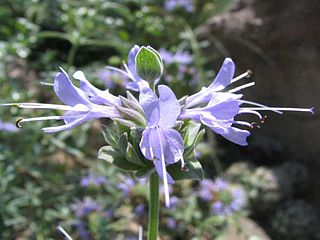
Salvia clevelandii, the fragrant sage, blue sage, Jim sage and Cleveland sage, is a perennial plant that is native to Southern California and northern Baja California, growing below 900 m (3,000 ft) elevation in California coastal sage and chaparral habitat. The plant was named in 1874 by Asa Gray, honoring plant collector Daniel Cleveland.
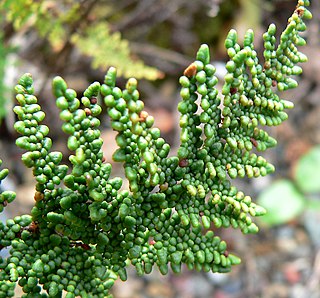
Myriopteris clevelandii, formerly known as Cheilanthes clevelandii, is a species of lip fern known by the common name Cleveland's lip fern. It is native to southern California and Baja California in Mexico. The leaf is divided into small, bead-like segments densely covered with scales beneath. In M. clevelandii, some of these scales are reduced to hairlike structures, which help distinguish it from the closely related M. covillei. It is usually found growing on exposed rock, particularly igneous rock.
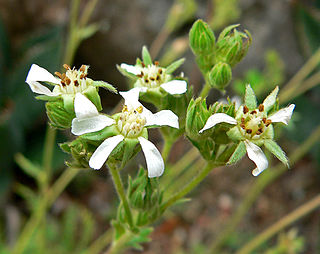
Potentilla clevelandii, also known as Cleveland's horkelia, is a species of flowering plant in the rose family. It is native to the Peninsular Ranges of southern California and northern Baja California.
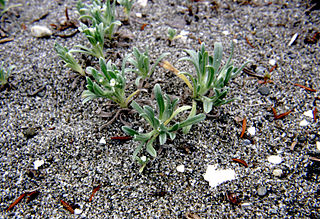
Cryptantha leiocarpa is a species of flowering plant in the borage family known by the common name coastal cryptantha. It is native to the coastline of Oregon and California where it grows in sandy areas such as beaches.
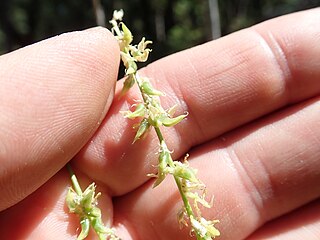
Astragalus clevelandii is an uncommon species of milkvetch known by the common name Cleveland's milkvetch. It is endemic to northern California, where it grows in moist areas of the North Coast Ranges. It is a member of the serpentine soils flora.

Cryptantha microstachys is a species of flowering plant in the borage family known by the common name Tejon cryptantha. It is native to California and Baja California, where it grows in several types of habitat, including chaparral in the coastal and inland hills and mountains. It is an annual herb producing a branching or unbranched stem 10 to 50 centimeters tall which is coated in hairs and bristles. The hairy leaves are linear to oblong in shape and up to 4 centimeters long. The inflorescence is a length of bristly developing fruits tipped with open flowers with five-lobed white corollas just a few millimeters wide.

Malacothrix clevelandii is a species of flowering plant in the family Asteraceae known by the common name Cleveland's desertdandelion. It is native to parts of the southwestern United States and Baja California, where it can be found most often in chaparral, including cleared and disturbed areas such as slopes recently burned by wildfire. The plant is also found in southern South America where it is an introduced species. It is an annual herb producing a flowering stem up to about 35 centimeters in maximum height. The toothed leaves are largest at the base of the plant, and reduced farther up. The inflorescence is an array of flower heads each bearing rings of pale yellow ray florets roughly half a centimeter long.

Diplacus clevelandii is an uncommon species of monkeyflower known by the common name Cleveland's bush monkeyflower. It was formerly known as Mimulus clevelandii.

Bloomeria clevelandii is a rare species of flowering plant that is known by the common name San Diego goldenstar. It is native to a strip of scrub and coastal grassland in San Diego County, California, and adjacent Baja California. Genetic analysis of several morphologically similar genera shows that this species, which was named Muilla clevelandii for several decades, is not very closely related to the other members of Muilla and is moved back to Bloomeria.
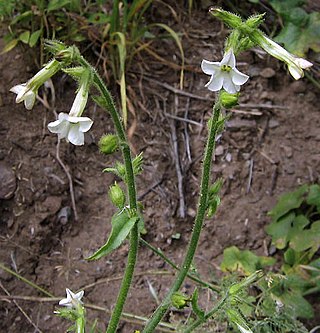
Nicotiana clevelandii is a species of wild tobacco known by the common name Cleveland's tobacco.
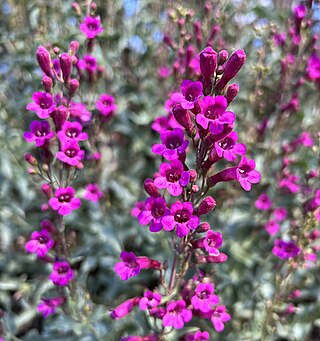
Penstemon clevelandii is a species of penstemon known by the common name Cleveland's beardtongue. It is native to southern California and Baja California, where it grows in mountain and desert habitat such as scrub, woodland, and chaparral. It is a perennial herb with upright, branching stems 70 centimeters in maximum height. The thick leaves are oval in shape, sometimes toothed, and 2 to 6 centimeters in length. The inflorescence produces tubular flowers with expanded, lipped mouths. The flower is pink to magenta in color, up to 2.4 centimeters in length, and somewhat glandular on the outer surface.

Salvia munzii is a semi-evergreen perennial species of sage known by the common name Munz's sage or San Miguel Mountain sage. It is native to northern Baja California, Mexico, and it can be found in a few locations just north of the border in San Diego County, California, where it is particularly rare. It is characterized by small leaves and clear blue flowers. It is a member of the coastal sage scrub and chaparral plant communities.
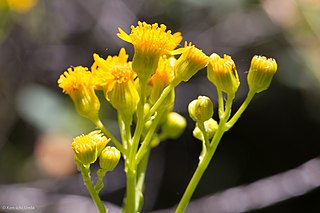
Packera clevelandii is an uncommon species of flowering plant in the aster family known by the common name Cleveland's ragwort. It is endemic to California, where it is known from only two small regions, a section of the North Coast Ranges around Napa County and a part of the Sierra Nevada foothills on the opposite side of the Sacramento Valley. The plant grows in shrubby chaparral on serpentine soils.

Castilleja beldingii is a species of hemiparasitic plant in the broomrape family, formerly the only species in the genus Clevelandia, it was moved to the genus Castilleja, the 'indian paintbrushes', in 2009.

The arrow goby is a species of goby native to marine and brackish waters of the Pacific coast of North America from British Columbia to Baja California. This species grows to a length of 6.4 centimetres (2.5 in) SL, though most do not exceed 4.2 centimetres (1.7 in) TL. This fish can also be found displayed in public aquaria. This species is the only known member of its genus.

McGinty Mountain is a gabbroic mountain located in San Diego County, California near Jamul. Because of the gabbroic soil, the mountain supports numerous rare and endemic plant species, including half of California's population of the Dehesa nolina. The mountain belongs to an ecological preserve collectively managed by The Nature Conservancy, the California Department of Fish and Wildlife, and the San Diego National Wildlife Refuge. The mountain is accessible through a 4.7 mi (7.6 km) long out-and-back hiking trail.

Daniel Cleveland was an American lawyer, politician, civic leader and botanist.




















